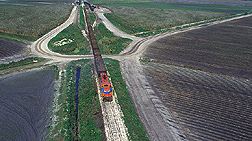This page has been archived and is being provided for reference purposes only. The page is no longer being updated, and therefore, links on the page may be invalid.
Read the magazine story to find out more. |
|
New Sugarcane Variety Resists Major Diseases
By Alfredo FloresJanuary 4, 2006
Sugarcane growers in Florida are quickly adopting a new variety that has shown resistance to the major yield-limiting diseases common there. Developed by scientists with the Agricultural Research Service (ARS), the University of Florida and the sugarcane industry, the new variety is known as CP 89-2143 and has a high sugar content from October through March--roughly the entire sugarcane harvest season.
ARS scientists Barry Glaz, Jimmy D. Miller, Peter Y.P. Tai and Jack C. Comstock at the agency's Sugarcane Field Station in Canal Point, Fla., collaborated with James M. Shine Jr. of the Florida Sugar Cane League and Christopher W. Deren, formerly with the University of Florida, to develop the new variety. ARS is the U.S. Department of Agriculture’s chief in-house scientific research agency.
As the nation’s largest producer of sugarcane and sugar, Florida fills more than 22 percent of the nation’s domestic sugar needs. The sugar industry in Florida processes 2 million tons of raw and refined sugar each year, adding more than $2 billion to the state's economy.
At the heart of the Florida sugar industry is Lake Okeechobee, in the area where approximately 450,000 acres of sugar cane are grown annually. Proximity to the lake is important, because it offers cold moderation to the tender cane during occasional harsh winter weather.
Just a quarter of a mile east of Lake Okeechobee, Comstock and his colleagues have been tackling some of the biggest problems facing Florida’s sugar industry. For example, a freeze can come anytime between December and late March, causing sugarcane to deteriorate. Growers are always searching for varieties with freeze tolerance that will give them extra time in which to harvest their crop, and CP 89-2143 is one of these highly sought-after, freeze- tolerant varieties.
CP 89-2143’s acreage has increased quickly, from just 1 percent of sugarcane acreage in the state in 2000 to 14.9 percent in 2004. It is expected that updated figures will show CP 89-2143 to easily exceed 15 percent of Florida’s total sugar cane acreage.
More information about this research is available in the January issue of Agricultural Research magazine.

